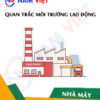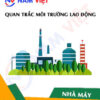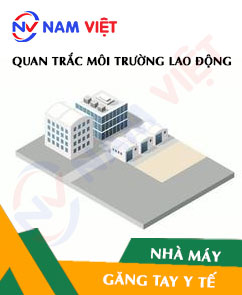Occupational environment monitoring of a motorcycle parts manufacturing factory
99,000 ₫
Note: The above price is calculated for one sample, prices may fluctuate depending on the area of the environment to be monitored and market movements. For more accurate price support, please refer to the price list or contact our consulting staff directly.
Monitoring the environment of a motorcycle spare parts manufacturing factory is a session of collecting, analyzing, and evaluating factors at the workplace that may be harmful to workers’ health.
Table of Contents
Toggle1. Overview of the motorcycle parts factory
a. What is a motorcycle parts factory?
Factory of motorcycle parts is a production facility specializing in the manufacturing of components and spare parts used in motorcycles. This factory is usually equipped with modern machinery and technology to produce parts such as wheels, exhaust pipes, clutches, turn signals, front and rear lights, clutch assemblies, brake systems, and many other components.
The production stages in this factory typically include raw material processing, precision machining, tropical casting, welding, electroplating, coating, assembly, and quality inspection. Through the production process, motorcycle parts are manufactured to meet the required technical and quality standards.
The motorcycle parts factory can operate as an independent unit or as part of a larger factory specializing in the production of components and parts for the automobile and motorcycle industry.
The purpose of the motorcycle parts factory is to provide high-quality, reliable, and safe parts for motorcycle systems, meeting the needs of the market and users.

b. Production stages in the motorcycle parts factory
The production stages in the motorcycle parts factory may include the following steps:
- Raw material processing: The process of machining and preparing necessary raw materials for producing motorcycle parts, including cutting, bending, welding, or casting materials such as metal, plastic, rubber, and composite materials.
- Precision machining: Using precise machinery and technology to process parts according to required dimensions, shapes, and accuracy. Processes include turning, milling, grinding, drilling, and pressing.
- Tropical casting: The process of casting motorcycle parts from metal or metal alloys using tropical casting methods, including high-pressure casting or compression casting.
- Welding: Using welding methods to join metal parts together to form components or larger assemblies.
- Electroplating: The process of electroplating to protect parts from corrosion and create shiny, scratch-resistant, or aesthetically pleasing surfaces.
- Coating: Using coating processes to add color and protect the surface of motorcycle parts. This may include spray painting, electrostatic painting, or other coating techniques.
- Assembly: The stage of assembling produced parts and components into modules or final products. The assembly process may involve the use of machinery, tools, and specialized assembly techniques.
- Quality inspection: The process of checking and ensuring the quality of motorcycle parts before they are released to the market. This includes checking dimensions, precision, durability, strength, and other factors to ensure functionality and safety of the parts.

c. Types of machinery used in the motorcycle parts factory
In the motorcycle parts factory, many types of machinery and equipment are used to perform production stages. Below are some common machines in the motorcycle parts manufacturing industry:
- Lathe machine: Used for machining metal parts such as shafts, bearings, and other components.
- Milling machine: Used for machining flat surfaces, grooves, and complex-shaped parts.
- Grinding machine: Used for polishing, abrasion, and precision machining of metal parts.
- Plastic injection molding machine: Used in the production of plastic parts, including molds and plastic injection machines to form components.
- Die-casting machine: Used to cast metal parts by applying high pressure to molten material.
- Laser cutting machine: Uses laser technology to cut, engrave, and mark metal parts and other materials.
- Welding machine: Used to join metal parts together through welding processes.
- Electroplating machine: Used to apply electroplating to metal surfaces to protect them from corrosion and create shiny, scratch-resistant finishes.
- Coating machine: Used for coating motorcycle parts, including spray paint machines, electrostatic paint machines, and other coating systems.
- Quality inspection machines: Includes machines and equipment to test accuracy, durability, and compliance with quality standards of produced parts.

d. What occupational diseases can workers in motorcycle parts factories suffer from?
Workers in motorcycle parts factories may suffer from certain occupational diseases due to environmental and work-related factors. Below are some common occupational diseases in the motorcycle parts industry:
- Respiratory diseases: Due to exposure to strong fumes from chemicals such as solvents, metal compounds, grinding dust, welding smoke, workers may suffer from pneumonia, rhinitis, sinusitis, and occupational lung diseases.
- Skin diseases: Contact with chemicals such as oil, solvents, rust inhibitors, paint, and adhesives may cause skin irritation, dermatitis, eczema, and other skin problems.
- Ear, nose, throat diseases: Causes such as noise from machines, mechanical tools, and chemical fumes may damage the ear, nose, throat and lead to issues such as hearing loss, otitis media, rhinitis.
- Spine and joint diseases: Work involving heavy lifting, incorrect postures, continuous vibrations, or impacts may lead to cervical spondylosis, back pain, arthritis, and joint degeneration.
- Muscle and nerve diseases: Continuous work in unnatural postures requiring high physical effort may cause muscle fatigue, strain, and neurological problems such as nerve injuries and degeneration.
- Temperature and light-related illnesses: Working in environments with poor temperature and lighting may cause heatstroke, cold stress, and skin damage due to strong light exposure.
- Toxic exposure diseases: Contact with toxins such as lead, mercury, dyes, additives, and organic solvents may cause poisoning and health issues such as lead poisoning, mercury poisoning, and other serious conditions.
To prevent occupational diseases, it is necessary to comply with occupational safety measures, use appropriate personal protective equipment, ensure proper ventilation, and manage environmental waste correctly. At the same time, periodic health checks and occupational safety training are essential to protect workers’ health.

e. Common motorcycle parts on the market
There are many common motorcycle parts on the market, each serving a specific function of the vehicle. Here are some examples of popular motorcycle parts:
- Engine components: Includes pistons, cylinders, carburetors, transmission parts (clutch, rollers, camshafts), cooling systems (water pumps, cooling fans).
- Brake system: Includes front and rear brakes, hydraulic pumps, brake cylinders, disc or drum brake components.
- Suspension system: Includes front and rear shock absorbers, suspension tubes, springs, and related accessories.
- Electrical system: Includes generators, batteries, electrical wiring, lighting, electronic carburetors, speedometers, and other electrical systems.
- Frame and body components: Includes footrests, mounting parts, dashboards, seats, protective covers, and other related parts.
- Fuel system: Includes fuel tanks, fuel hoses, fuel pumps, fuel filters, and other related components.
- Transmission system: Includes gearboxes, drive shafts, primary drives, and related parts.
- Tires and rims: Includes tires, rims, connecting tubes, and other related parts.
- Starting and ignition system: Includes starters, CDI units, sensors, and other related components.
2. Overview of occupational environment monitoring services
a. What is occupational environment monitoring in motorcycle parts factories?
Occupational environment monitoring (or workplace environment measurement) in motorcycle parts factories is the activity of collecting, evaluating, and analyzing measurement indicators of workplace environmental factors at the motorcycle parts factory, in order to implement timely measures to minimize environmental harm to workers’ health and prevent occupational diseases. Occupational environment monitoring is a mandatory regulation for motorcycle parts factories.
Occupational environment monitoring plays the most important role in protecting and improving workers’ health because the main resource of enterprises, directly generating profits, is workers. Workers who are regularly exposed to risk factors and occupational hazards beyond permissible standards will have their health affected and may develop occupational diseases.
REGISTER FOR OCCUPATIONAL ENVIRONMENT MONITORING SERVICES
b. Occupational environment monitoring program of Nam Viet
The occupational environment monitoring program of Nam Viet is a program developed by monitoring engineers in the field of occupational safety and environmental protection. With the goal of ensuring health and safety for workers, this program uses modern measurement methods to monitor air quality, water, microclimate factors, physical conditions, dust… in the workplace environment. This is a very important program to ensure a safe working environment and protect workers’ health.
In addition, the occupational environment monitoring program of Nam Viet also plays an important role in researching and developing new solutions to improve workplace environment quality. With the dedication and professionalism of the monitoring experts, Nam Viet’s exclusive monitoring program is becoming a breakthrough in occupational safety management and environmental protection in Vietnam.

c. Standardization in workplace environment measurement procedures
Standardization in workplace environment measurement procedures of Nam Viet is a very important aspect to ensure the quality of measurement results. To ensure accuracy and reliability of measurement results, this program applies recognized standards and standardized procedures of Ho Chi Minh City Department of Health. This ensures that collected data can be used with high reliability in evaluating workplace environments and making decisions to improve conditions and protect workers’ health.
These standardized procedures also ensure that measurements are conducted by a team of monitoring specialists with high qualifications and years of experience, helping managers and experts trust An Toan Nam Viet’s results and make accurate, valuable decisions in protecting workers’ health and the environment.
By applying standardization in workplace environment measurement procedures, Nam Viet demonstrates its commitment to ensuring a safe working environment and protecting workers’ health, while also contributing positively to the development and improvement of occupational safety management and environmental protection in Vietnam.
d. Monitoring report results for motorcycle parts factories
The results of occupational environment monitoring are prepared according to Form No. 04 Appendix III issued under Decree 44/2016/ND-CP and made in 02 copies: 01 copy sent to the labor facility that signed the monitoring contract and 01 copy stored at the monitoring organization.
The retention period for occupational environment monitoring results is permanent, in accordance with legal regulations.

e. Frequency of occupational environment monitoring under the law
According to Clause 2 of Article 18 of the Occupational Safety and Hygiene Law 84/2015/QH13, employers must organize occupational environment monitoring to assess harmful factors at least once a year.
f. Deadline for submitting occupational environment monitoring reports under the law
The deadline for report submission is before December 31 each year. Enterprises in production facilities are required to submit occupational environment monitoring reports to the Department of Health at the locality where their headquarters or workplaces are located.
When there are changes in technological processes, production processes, or when renovating and upgrading labor facilities that may generate new harmful factors to workers’ health, enterprises must update occupational hygiene records related to these harmful factors requiring occupational environment monitoring.
g. Regulations on administrative penalties for violations of occupational environment monitoring by employers
According to Article 27 of Decree No. 12/2022/ND-CP dated 17/01/2022 on administrative penalties in the field of labor, social insurance, and Vietnamese workers working abroad under contracts:
- Clause 2: A fine of 2,000,000 – 5,000,000 VND for employers who fail to publicly announce to workers at the monitoring site and inspection locations the results of occupational environment monitoring and assessments of hazardous factors at the workplace.
- Clause 3: A fine of 20,000,000 – 40,000,000 VND for employers who fail to conduct occupational environment monitoring to control health risks to workers as prescribed by law.
- Clause 4: A fine of 40,000,000 – 60,000,000 VND for employers who collude with organizations conducting occupational environment monitoring to commit fraud in monitoring activities, but not to the extent of criminal prosecution.
3. Harmful environmental factors for workers in motorcycle parts manufacturing factories
When working in motorcycle parts manufacturing factories, workers may be exposed to several harmful environmental factors. Below are some potential environmental factors that can affect workers’ health:
- Dust: The process of manufacturing motorcycle parts often generates dust from cutting, grinding, milling, and metal machining. Inhaling metal dust or chemical compound dust can damage the respiratory system and cause health problems such as pneumonia, asthma, and other respiratory issues.
- Chemicals: Motorcycle parts production often uses many chemicals such as solvents, coatings, detergents, and adhesives. Long-term exposure to these substances can cause skin irritation, dermatitis, skin allergies, and may harm the nervous system, digestive system, and kidneys.
- Noise: Machinery and production processes in motorcycle parts factories often create high noise levels. Continuous noise can cause ear problems, reduced intelligence, stress, and affect overall health.
- Toxic gases: The production process may generate toxic gases such as welding fumes, CO2 gas, and volatile chemicals. Inhaling these toxic gases can endanger the respiratory system, internal organs, and cause serious health issues.
- Temperature and humidity: Some motorcycle parts production processes can create hot, humid, or cold environments. These unfavorable environmental conditions can cause fatigue, stress, and affect overall health.
REGISTER FOR OCCUPATIONAL ENVIRONMENT MONITORING SERVICE
4. Measures to improve the working environment in motorcycle parts manufacturing factories
To improve the working environment in motorcycle parts manufacturing factories and protect workers’ health, the following measures can be applied:
- Dust control: Establish an effective dust extraction system to minimize workers’ exposure to metal dust and chemical dust. Ensure regular cleaning, maintenance, and replacement of dust filter systems.
- Ensure ventilation and exhaust systems: Install ventilation and exhaust systems to remove toxic gases and chemical odors during production. Ensure good air circulation in the working area.
- Use protective equipment: Ensure workers are provided with suitable personal protective equipment such as masks, helmets, gloves, safety glasses, chemical protective clothing, and puncture-resistant shoes to protect against harmful environmental factors.
- Training and education: Provide training and education related to occupational safety, use of protective equipment, safe working procedures, and occupational disease prevention. Ensure workers clearly understand the impacts of environmental factors on health and know how to protect themselves.
- Inspection and maintenance of equipment: Conduct regular inspections and maintenance of machinery, equipment, and technological systems to ensure safe and effective operation. Repair or replace damaged or faulty components.
- Enhance industrial hygiene: Ensure the working area is kept clean and tidy. Manage and dispose of waste properly to avoid environmental pollution and health impacts on workers.
- Regular health checks and monitoring: Conduct periodic health checks for workers to detect early any health issues and apply timely preventive and treatment measures.
- Regularly organize occupational environment monitoring in factories and enterprises, collect and analyze harmful factors to workers, thereby adjusting and reducing hazards to prevent occupational diseases for them.
5. Benefits of regular occupational environment monitoring in motorcycle parts factories
An Toan Nam Viet provides businesses with excellent benefits when using occupational environment monitoring services in accordance with Decree 44/2016/ND – CP on the management and control of harmful factors in the working environment affecting workers.
- Businesses can proactively control harmful factors at workshops or factories.
- Receive advice and recommendations on measures to minimize harmful factors and improve the quality of the working environment.
- Indirectly protect human resources, the key factor in the enterprise’s development process.
- Minimize the harm of occupational diseases to human health, thereby reducing future medical treatment costs.
- Improve workers’ health, leading to guaranteed and maintained product quality as well as productivity.
- Comply with occupational safety laws, avoiding legal risks.
- Create prestige and professionalism in all aspects, thereby elevating the business’s brand.
The occupational environment monitoring service of Nam Viet is the solution to minimize the harm of occupational diseases, contributing to creating a healthy and high-quality working environment.

6. National Occupational Environment Monitoring Center
Occupational Environment Monitoring Center of Nam Viet is a professional unit in monitoring and measuring occupational environment quality across all provinces in Vietnam. With a team of experienced monitoring specialists, the center uses modern measuring equipment, ensuring accuracy and reliability.
In addition to providing monitoring services, the center also supports customers in planning, handling, and monitoring occupational environment issues. With the motto “customer-centered,” the center values customer satisfaction, meets all customer needs, and is committed to offering the best solutions for businesses.
REGISTER FOR OCCUPATIONAL ENVIRONMENT MONITORING SERVICE
With investment in technology, techniques, and human resources, Nam Viet’s monitoring center has become one of the reputable units in the field of occupational environment monitoring in Ho Chi Minh City with the following objectives:
- We always value brand reputation and the quality of our services.
- We provide customers with the best and most suitable solutions possible.
- Together with a team of Masters and Engineers with experience and expertise, we aim to protect the environment and benefit businesses.
- With Nam Viet’s Occupational Environment Monitoring team, your company will receive professional service from experts in the monitoring field, along with the best cost benefits.
The occupational environment monitoring process at Nam Viet includes the following basic steps:
- Before conducting occupational environment monitoring, our company always ensures that machinery and equipment serving monitoring are calibrated and adjusted according to legal regulations.
- Comply fully with the occupational environment monitoring procedures committed to the Department of Health.
- Report monitoring results truthfully to employers.
- If occupational environment monitoring results are unsafe for workers, Nam Viet company will support providing remedial solutions and the workplace will implement as follows:
- Implement measures to improve working conditions to minimize harmful factors and prevent occupational diseases.
- Organize health check-ups to detect occupational diseases and work-related illnesses early for workers in unsafe working environments.
- Provide allowances in kind for workers as prescribed by labor law.

7. Occupational environment monitoring service quotation
To help businesses conduct occupational environment monitoring professionally and effectively, Nam Viet provides customers with a quotation table for occupational environment monitoring services with reasonable costs and high quality.
- Our quotation table provides detailed information on the costs of monitoring services we are offering. This includes costs related to transportation, measurement, analysis, and reporting of results. Customers can be completely assured of the accuracy and reliability of the monitoring reports we provide.
- We are committed to always offering the most competitive and reasonable prices in the market, and we are also always ready to consult and answer all questions about monitoring services quickly and professionally.
- With Nam Viet’s quotation table, customers can easily choose service packages suitable for their needs. We are committed to bringing the highest satisfaction with professional service quality.
No comments yet












Review Occupational environment monitoring of a motorcycle parts manufacturing factory
There are no reviews yet.